Capitol Peak in Winter:
A Photographic Exposition
Winter Dayhike - Capitol Peak - No Summit
Approach: Moon Lake (winter route) from Snowmass TH
Date: 1-2-12
Length: 16 miles RT
Vertical: 5600 feet
Ascent Party: Muzik83 (Bobby) Dancesatmoonrise (Jim)
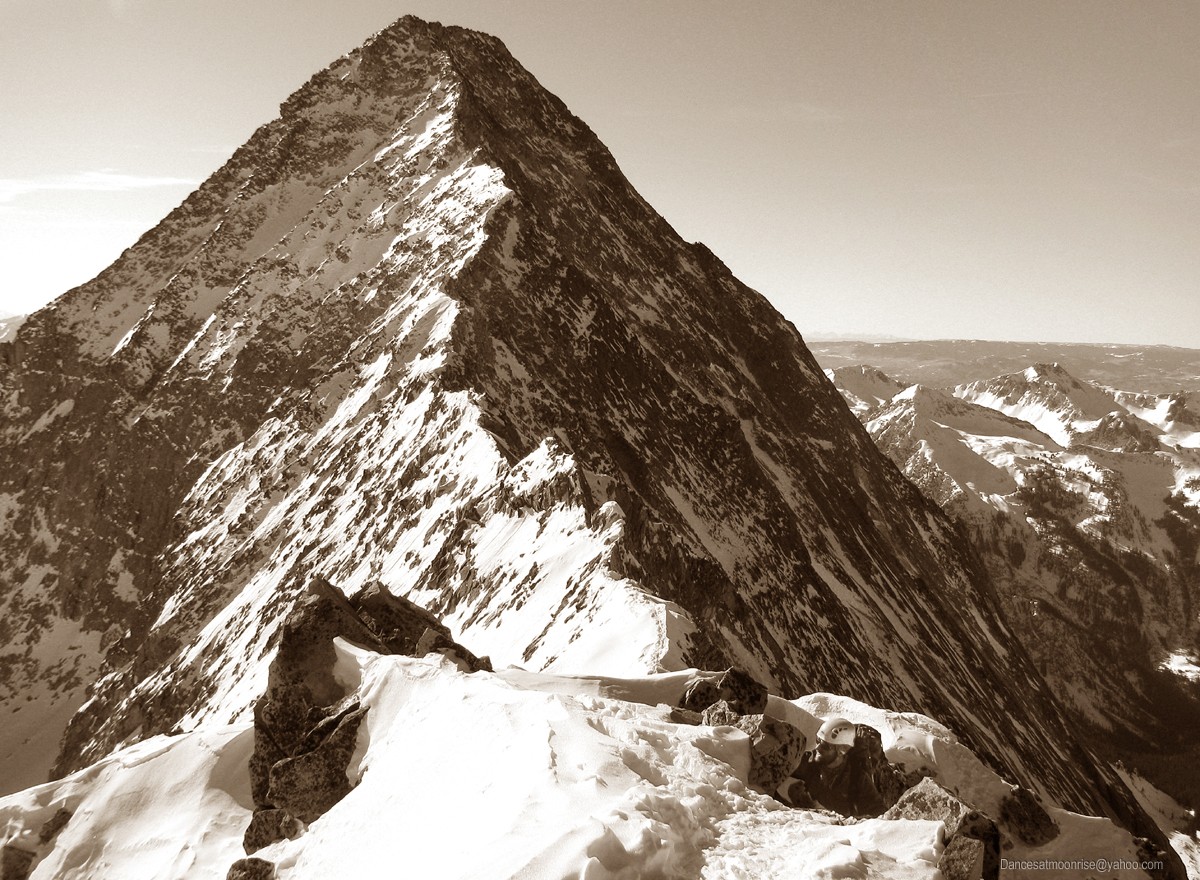
Capitol Peak, January 2, 2012. Bobby, lower right, regains K2 during the descent.
Prologue: Winter Planning
Playing with winter 14ers, one finds it natural to keep an eye out for winter potential during the dry season. Though September 25 is my first time on
Capitol Peak, I find myself sizing things up for winter. The conclusion, somewhat to my surprise, is that it does not appear to be the impossibility
I would have thought. The section from K2 to the summit goes well, though in retrospect I find myself wishing I'd done two things: One, take the
ridge all the way from the knife-edge to the summit, as this would be good preparation for a typical winter route; and Two, keep a better eye out for
how the rock protects, to have a more specific idea of what to put in a rack for this route. After the initial overview in September, I deem Capitol Peak
to be worth a shot in winter, with the proviso of excellent conditions and maximum use of daylight on the technical section.

Scouting snow-clad Capitol Peak during a May 2010 ascent of North Snowmass Peak.
Later in the fall, Noah contacts me with one of his typically hair-raising ideas for a first winter ascent. I like the idea of helping him bust trench on the
approach to Capitol, but his intended route is too risky for this old guy. We think about maybe having two teams of two - everyone contributes
on the approach, then one team does the hair-raising route, while the other team (the one I'm on,) does the more moderate northeast ridge.
We kind of shelve the idea for the time being.
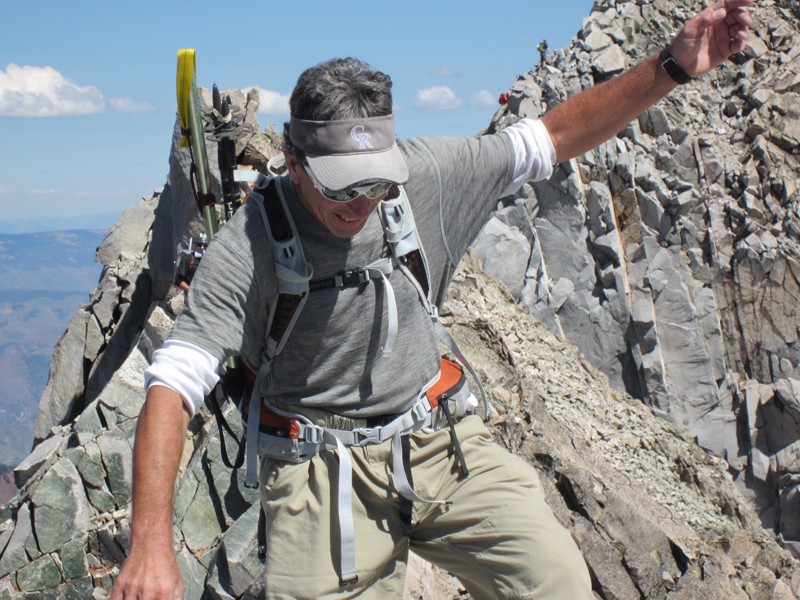
Those light, airy days of Fall...
As winter arrives, I'm hoping to finish off the Sangre, but Mother Nature has other ideas, pushing storms on a more southerly track than typical.
The Elk range is blessed with low snow and the lowest avy hazard I seem to remember in three winter seasons. Thoughts of Pyramid and Capitol
move to the front burner.
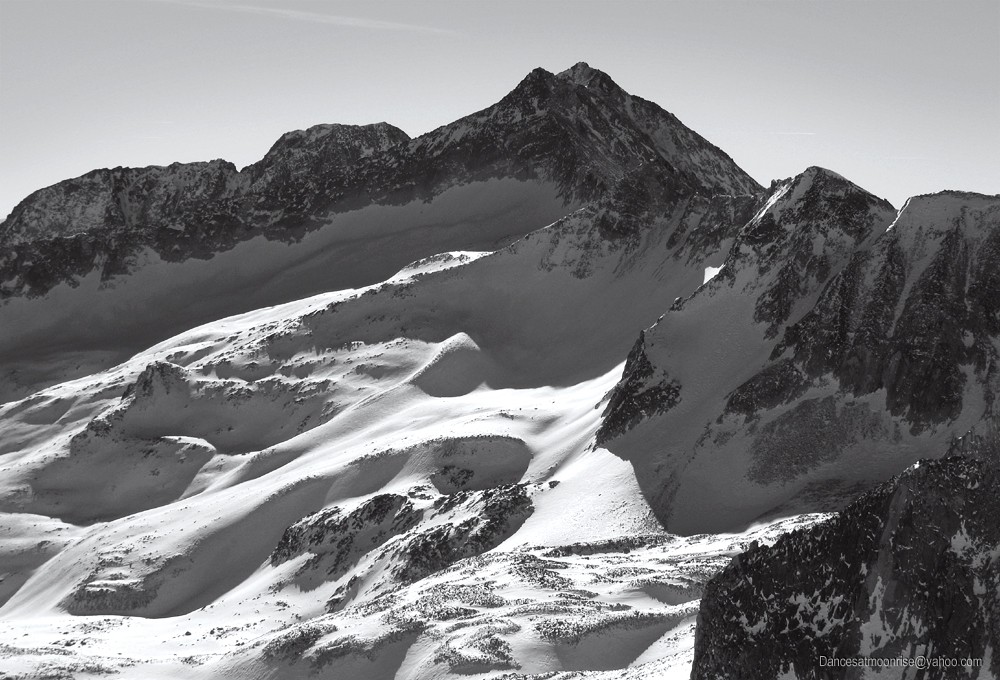
Snowmass and North Snowmass Peaks, seen from across the Pierre Lakes Basin, January 2, 2012.
Final Preparations
Following the first winter storm, a recon to Castle and Conundrum, the two easiest Elk range winter 14ers, serves as a preview. Brad, Andrew,
Bobby, and I bump into Sarah and Dominic on their descent. Sarah tells us about their recent trip to Capitol Peak on Christmas Eve. Bobby can barely
contain his excitement.
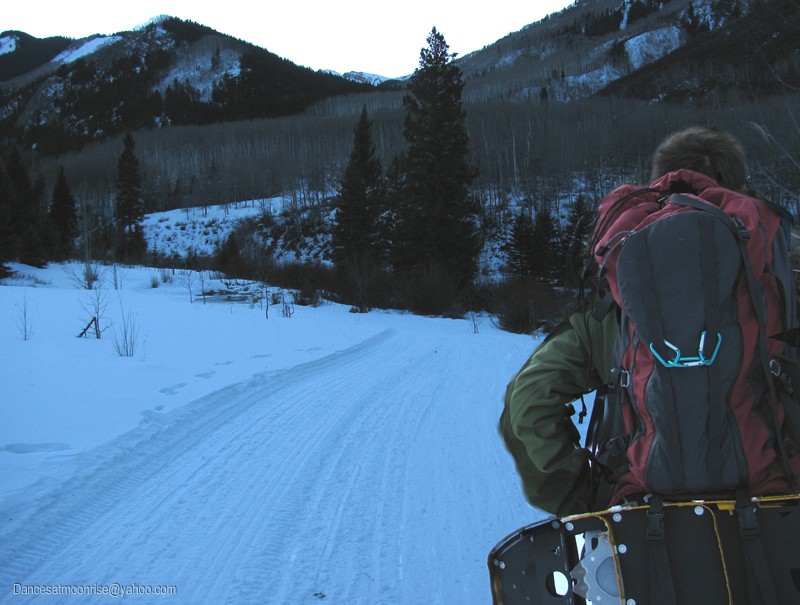
When do we get to play with the snowshoes?
The following week, Bobby suggests we give Capitol a shot as a daytrip. He's strong and fast, and I know he's capable of pulling the approach
in a day. I'm cool on the idea, and carefully explain that while I've considered it, Capitol Peak is a very serious winter 14er. Bobby has been up
to the knife edge three times, turned around each time by summer storms, so he's never been on the technical section. We've never tied in together.
Still, we hit it off well on Castle, and it's a joy to find a strong, fast partner that I know is capable of this grueling approach. I'm beginning to
come around to his way of thinking.
Bobby is getting to me with the logic that weather, avy, and snowpack conditions are about as perfect as we're going to get. The only hitch is a
wind event on December 31, which leaves plenty of windslab in its wake. The CAIC forecast bumps up following this event, but remains acceptable.
I still have some reservations about us going in.
About then, GFS modeling opens a beautiful window for January 2. It's hard to walk away from perfect conditions and an enthusiastic partner.
Have the planets aligned? Bobby conjectures that plenty of RFV locals have tracked the place up, but I'm guessing any tracks are now a chapter
out of Gone with the Wind. Yet, I'm confident we can earn this approach, and get it in a day. Besides, what's the downside in trying? As long as
we're willing to turn back at any sign of trouble, we get a great recon and a gorgeous day in the Elks. I've never been on the Moon Lake approach,
so may as well rack up some experience and a little more data on the camera's SD card.
Home Sweet Home: The Snowmass Trailhead
We spend the first day of the New Year scouting the next day's death march. This turns out to be critical. We find the start to be surprisingly well
traveled, and find a convenient way across the stream. We boot it for the first mile and a half, often through nearly dry conditions. But after the
first big hill, the snow gets deep. Confirming our suspicions, we find old tracks blown at first, and soon, completely obliterated. We push on till dark,
making quite a bit of headway before the return to the cars by headlamp and moonlight. It's a gorgeous calm evening; spirits run high. We turn in
after devouring a pizza Bobby brought over that morning from Glenwood. Really good stuff.
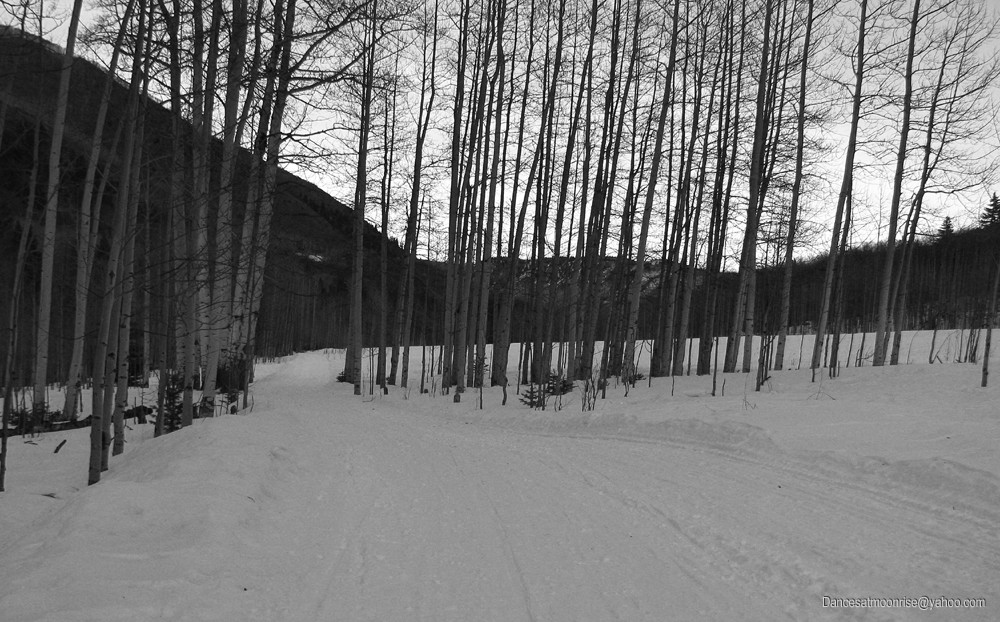
New Year's Day on the Moon Lake turnpike.
Time to Climb
It's a cozy 12 degrees according to the car's dashboard. I'm up an hour before the alarm and ready to unveil the results of my first serious alpine
experiment: The liter of hot coffee, which is in the thermos, which is wrapped in the down vest, which is stuffed into the stuff sack, all of which
has been pre-heated before leaving the house the day before, is a resounding success. It's still hot enough to call coffee. Thirty minutes later
I'm sufficiently caffeinated, packed, ready to rock, and already diuresing. (Does the mild diuretic effect of coffee demonstrate prophylaxis similar
to acetazolamide against the adverse effects of altitude? After three such anecdotal experiences, I'm beginning to think so.
Any volunteers for a 14ers.com randomized controlled study? : )
Meanwhile, Bobby is still sawing logs. I'm thinking the six hours we have planned to K2 might be just a tad optimistic, so, with a little guilt and
trepidation, I rouse him. By 4:00 am, we're hoofing it, an hour earlier than planned. Optimism is a good thing... An early start is even better.

Finding nearly dry conditions the night before has us hopeful on the morning of our big slog.
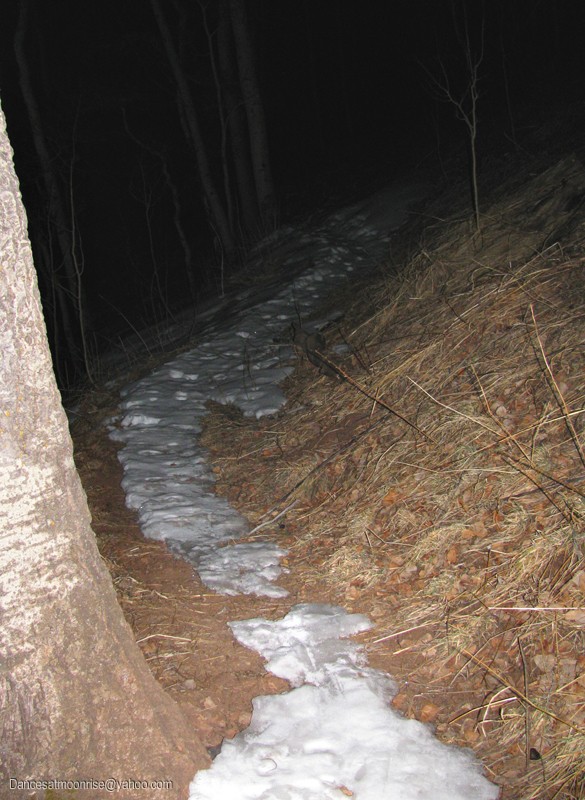
Although we have great conditions down low, the wind-blown snow higher up is hell-bent to wrench our pace. In the dark we miss the drop back into
the west Snowmass drainage; Bobby has been up this approach once before, and turns us back before we go too far amuck. The drainage is a mass
of downed timber, logs, branches, sugar snow, ice, and windslab. Bobby says that in summer, there is a trail through all this, so I figure we must
be paralleling the correct route. It's hard to tell in the dark, but we know the general direction, so we push on. Sometimes the little doggies know
an old route or the firmest line; I try to follow the pup tracks.

Betting on the dogs.
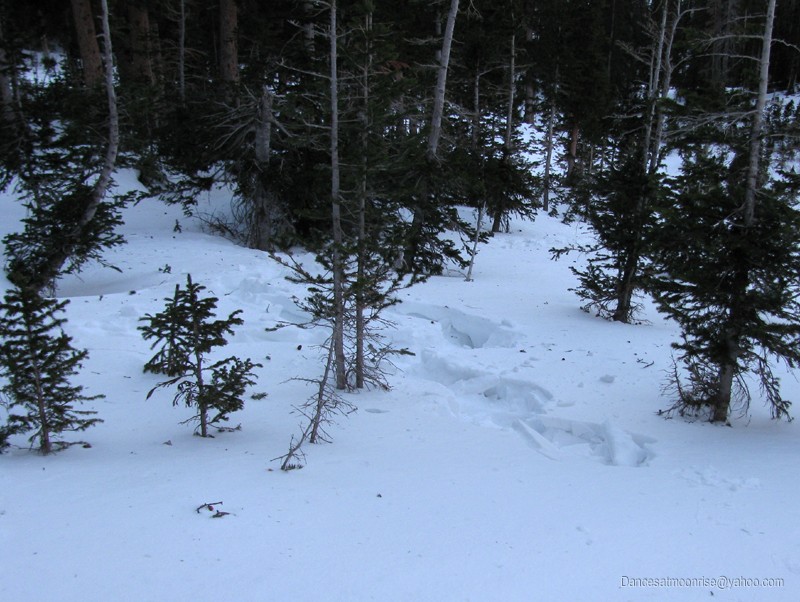
Gone with the Wind: The approach bares its teeth, breaking unpredictably.
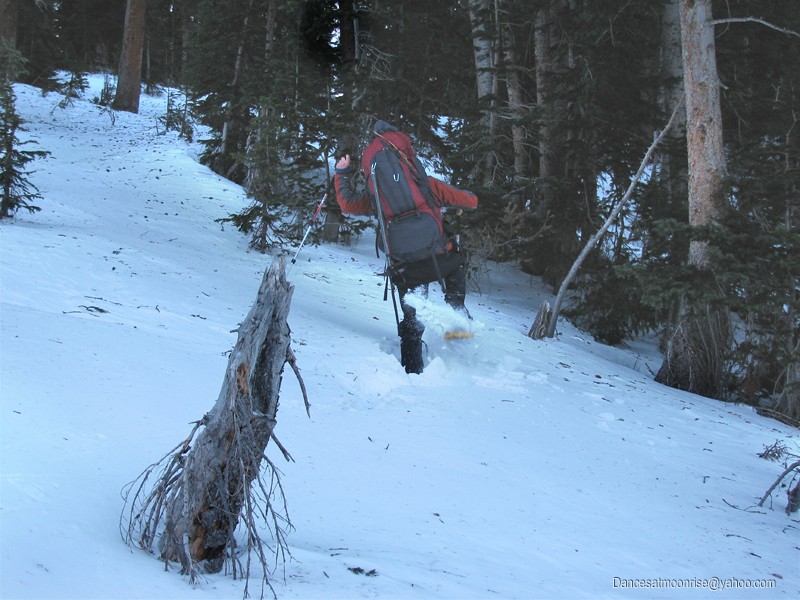
Gravy down low; earning our keep higher up.
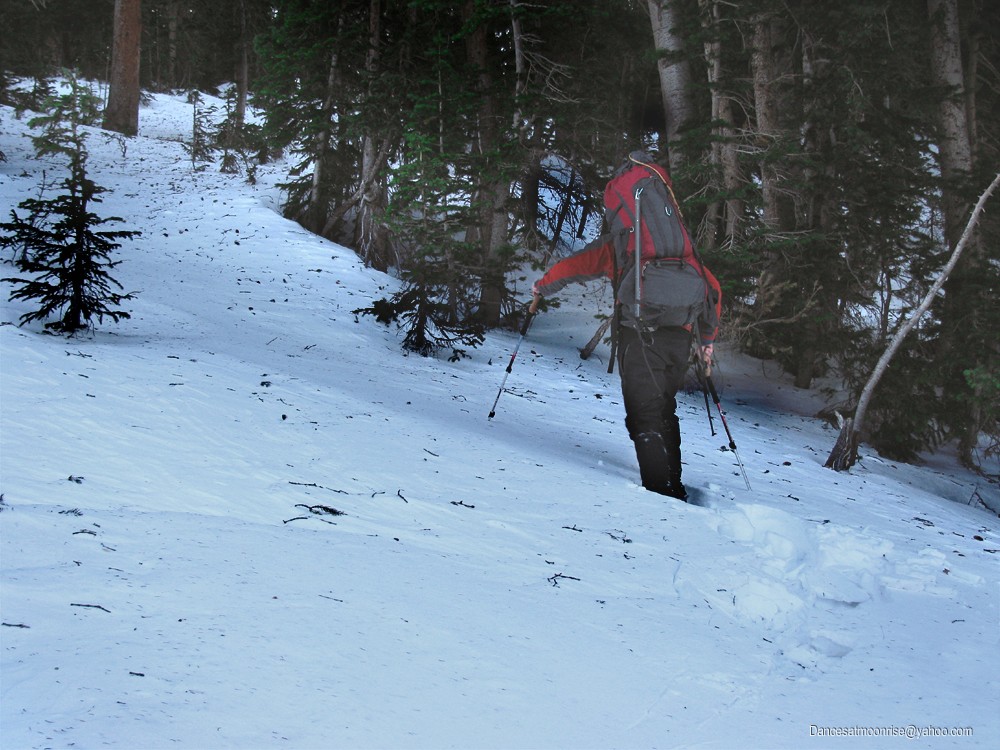
The Bobby machine.

Trenching made easy in 50,000 simple steps.
By first light, we're up near the head of the west Snowmass drainage. The windslab becomes unreliably breakable and we take turns postholing our way
to the head of the drainage and around the top to the right, and out toward Moon Lake. Just above treeline there's some slab that seems sketchy to me.
Bobby feels ok with it, giving me temporary relief from my snowpack anxiety disorder. At least, until I trigger the first WHUMPH! The saving grace is
that we're on no more than perhaps a 25 degree slope, and we're just about off the stuff. At least I have confirmation that my anxiety disorder is
functional, if not organic. Ah, here's Moon Lake. This is good.
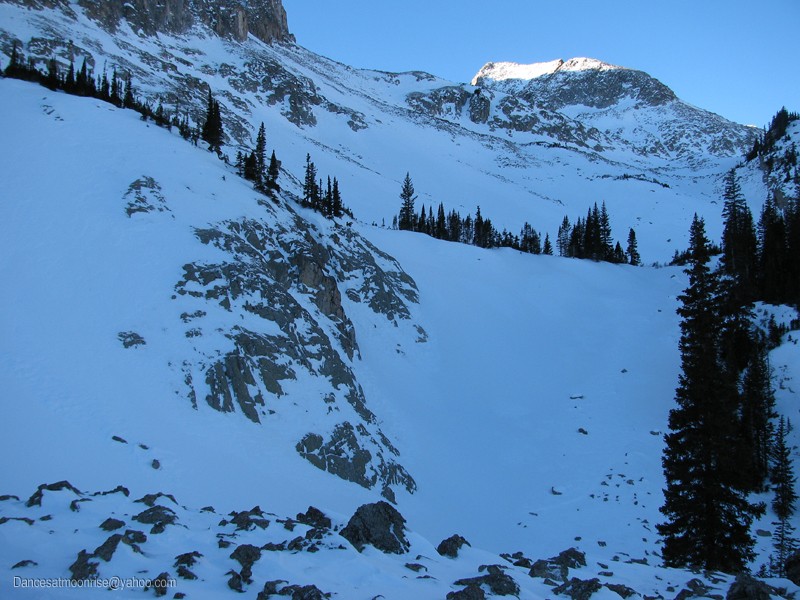
Windslab...
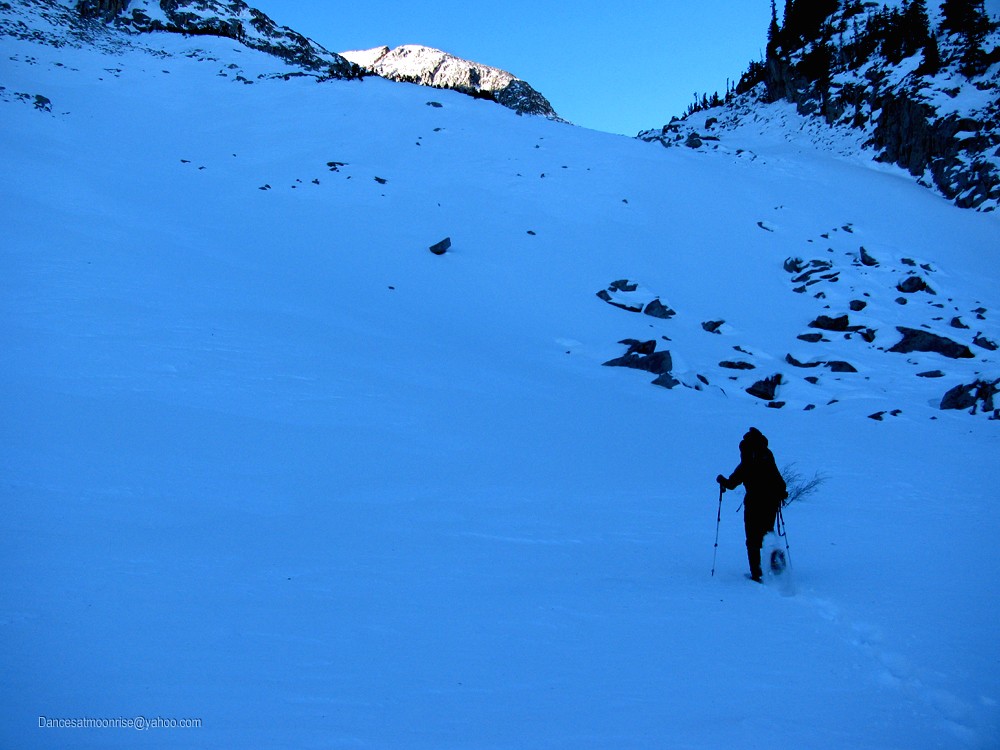
...alternating with deposition.
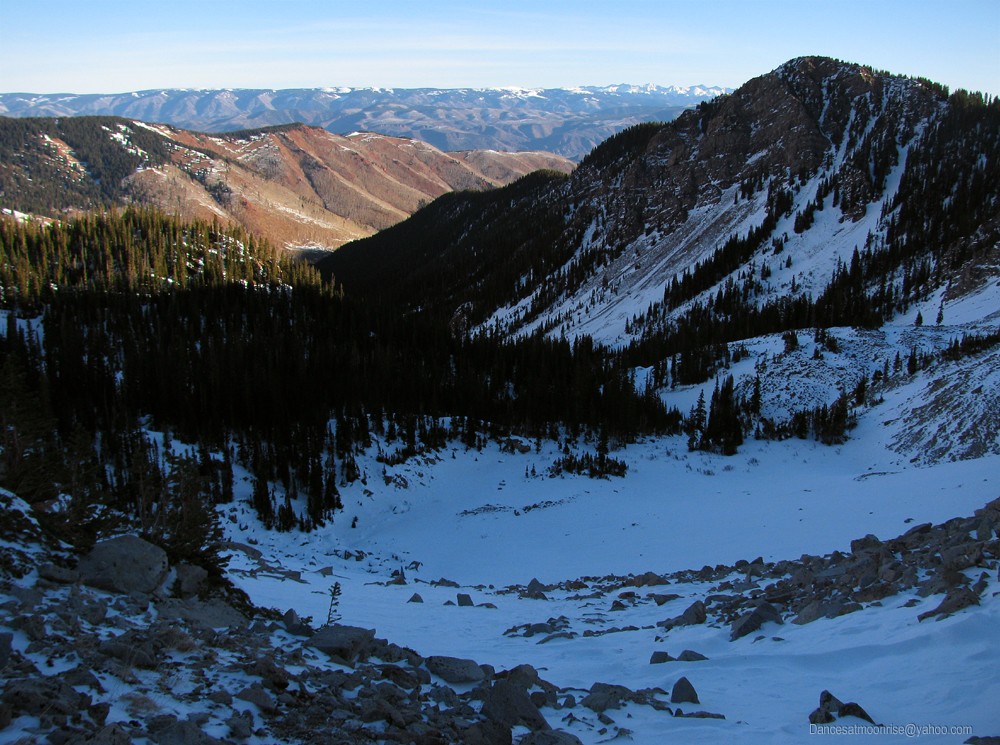
We try to stay in the rocks through here.
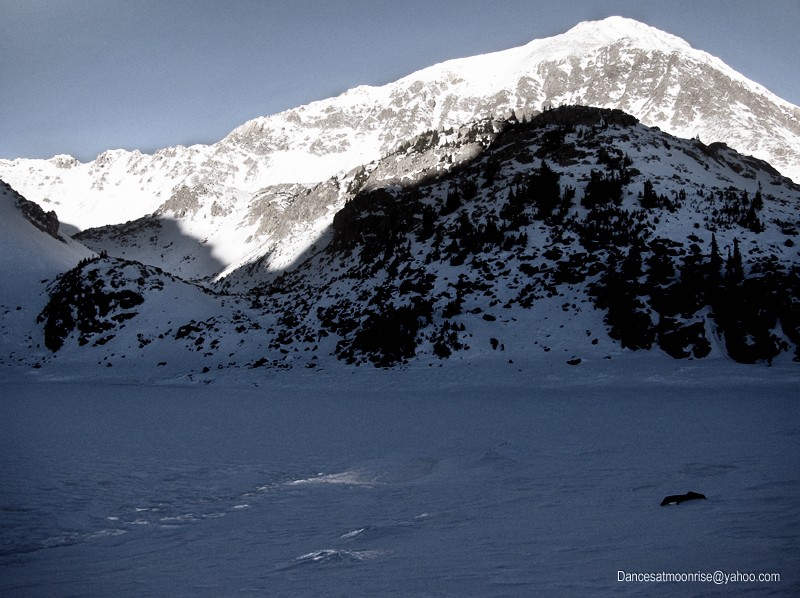
Moon Lake.
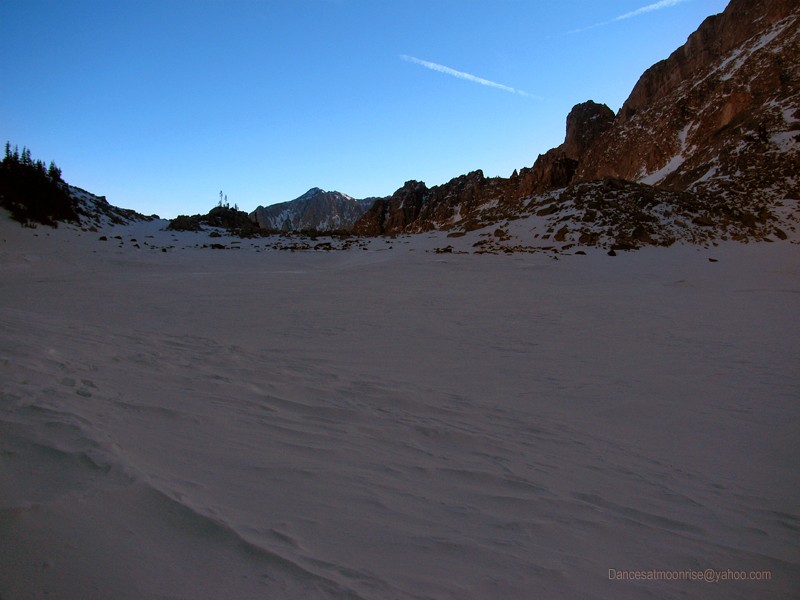
The sun is up, but not on us. I spy the Capitol-Daly saddle and get excited. I'd been worried what the boulderfield might be like, and find it pleasantly
more negotiable this time of year. The wind has at least bestowed a few benefits. We stay on top most of the way to K2. The Clark-K2 ridge is gorgeous.
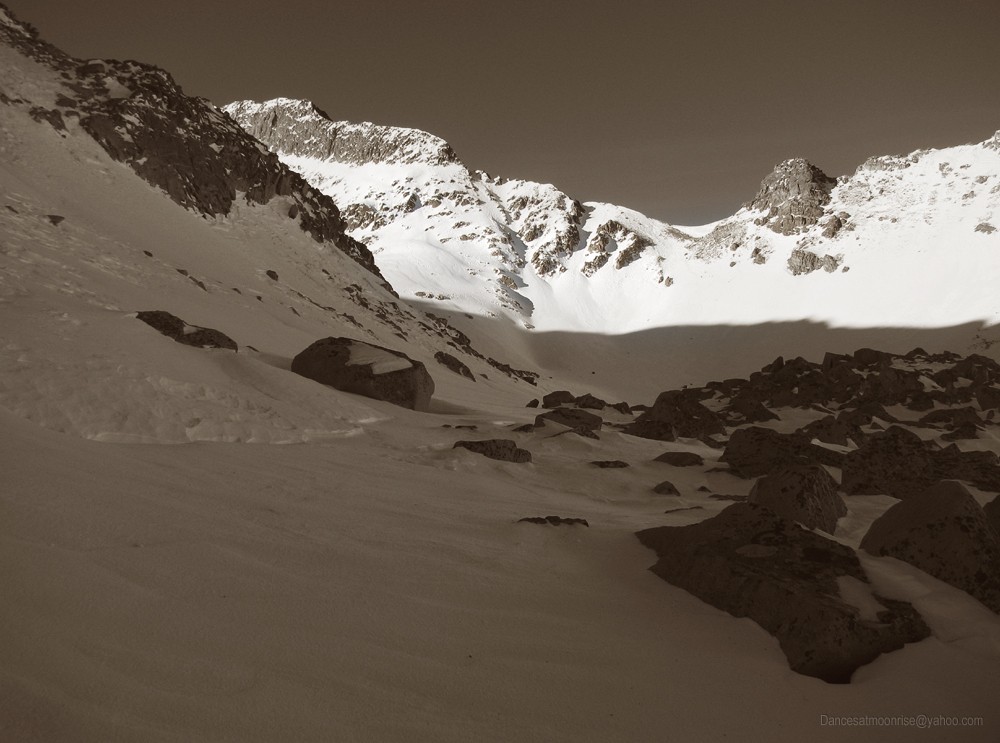
Many will recognize the Capitol-Daly saddle, below which the Moon Lake approach merges with the Capitol Creek approach.

The boulderfield.
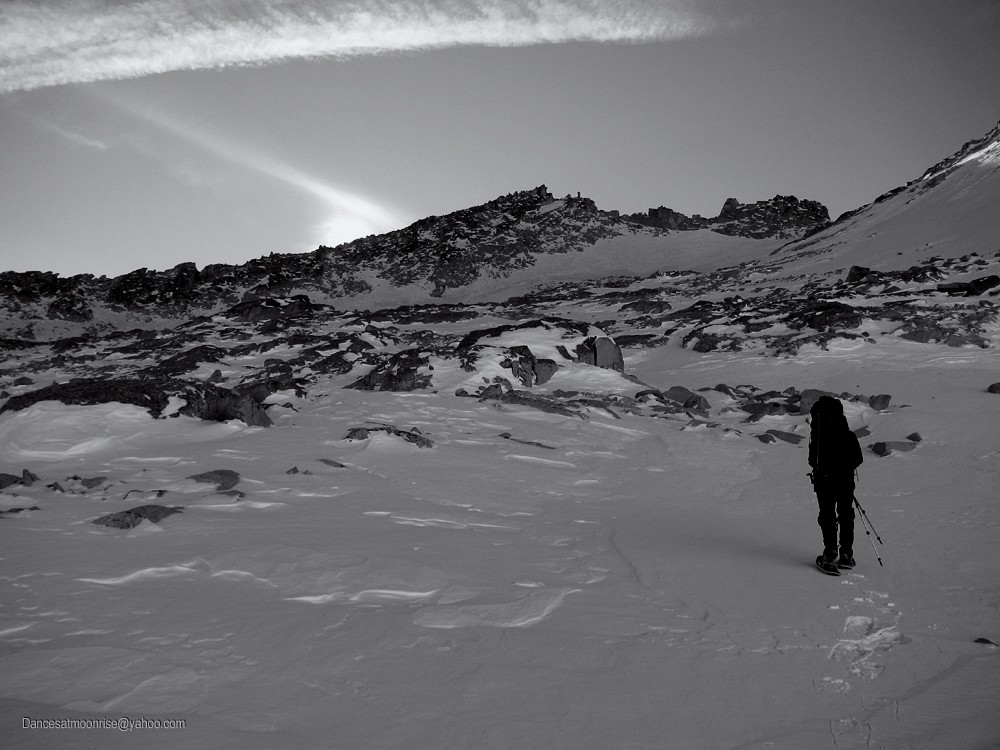
Winter light can be etherial.
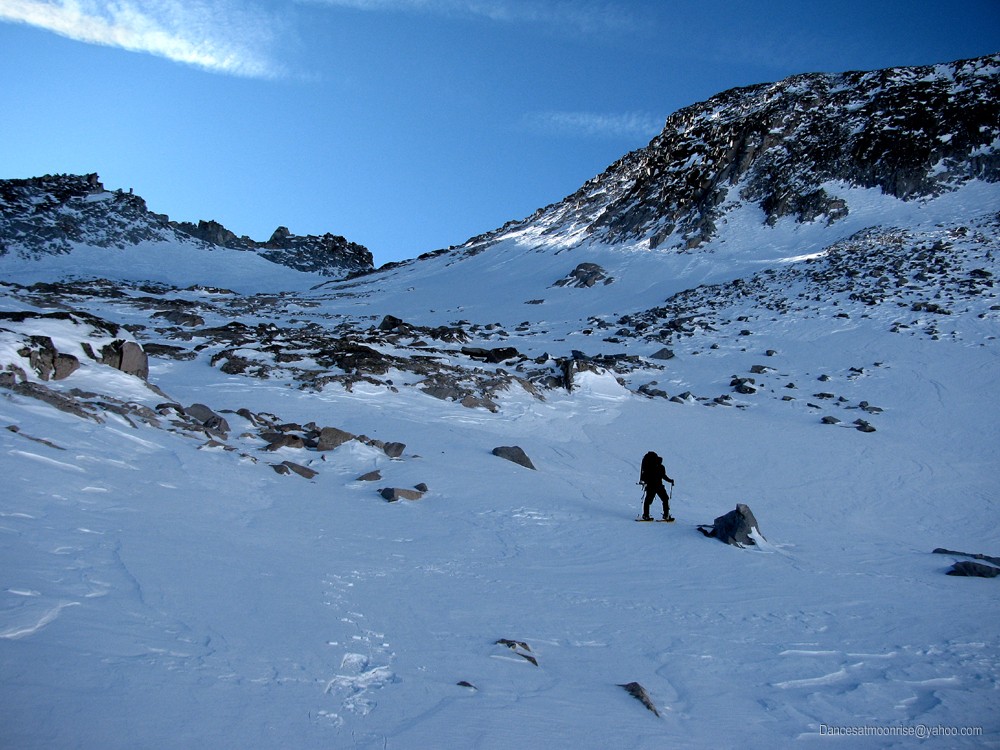
It's much easier to negotiate these boulders when they're not there.
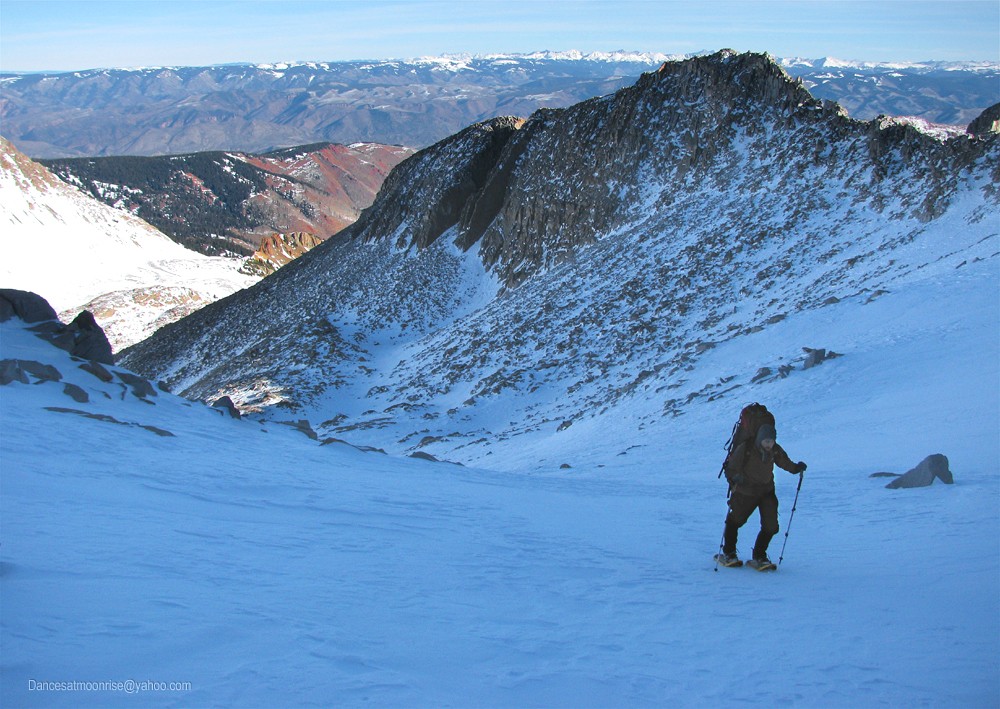
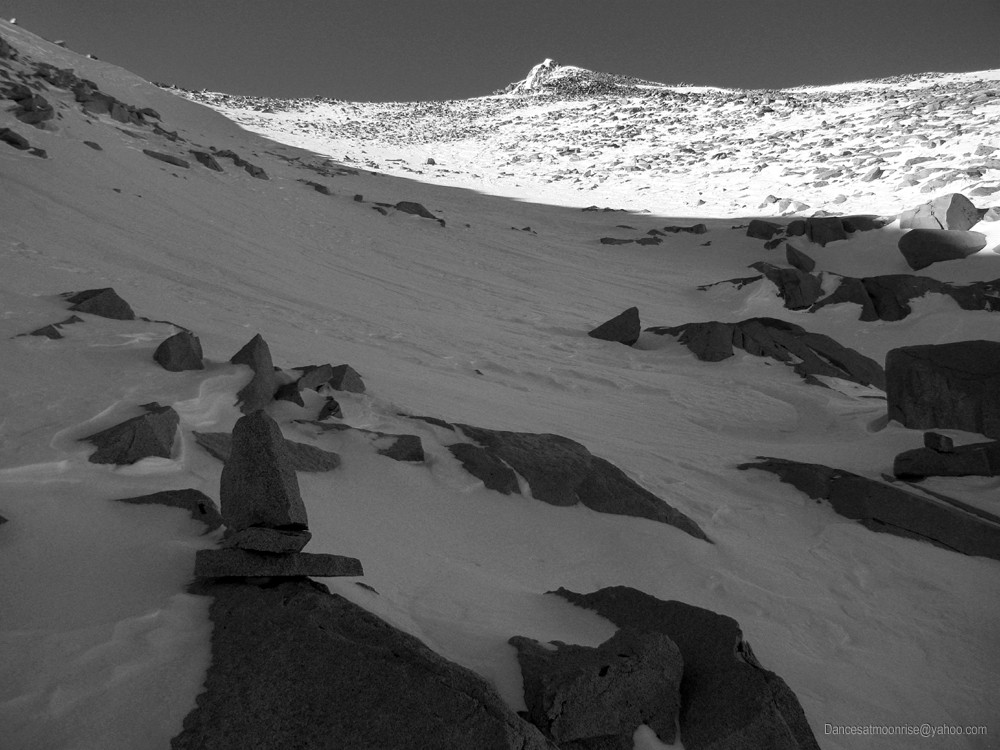
First view of K2. We find the rock cairn at lower left a little superfluous.
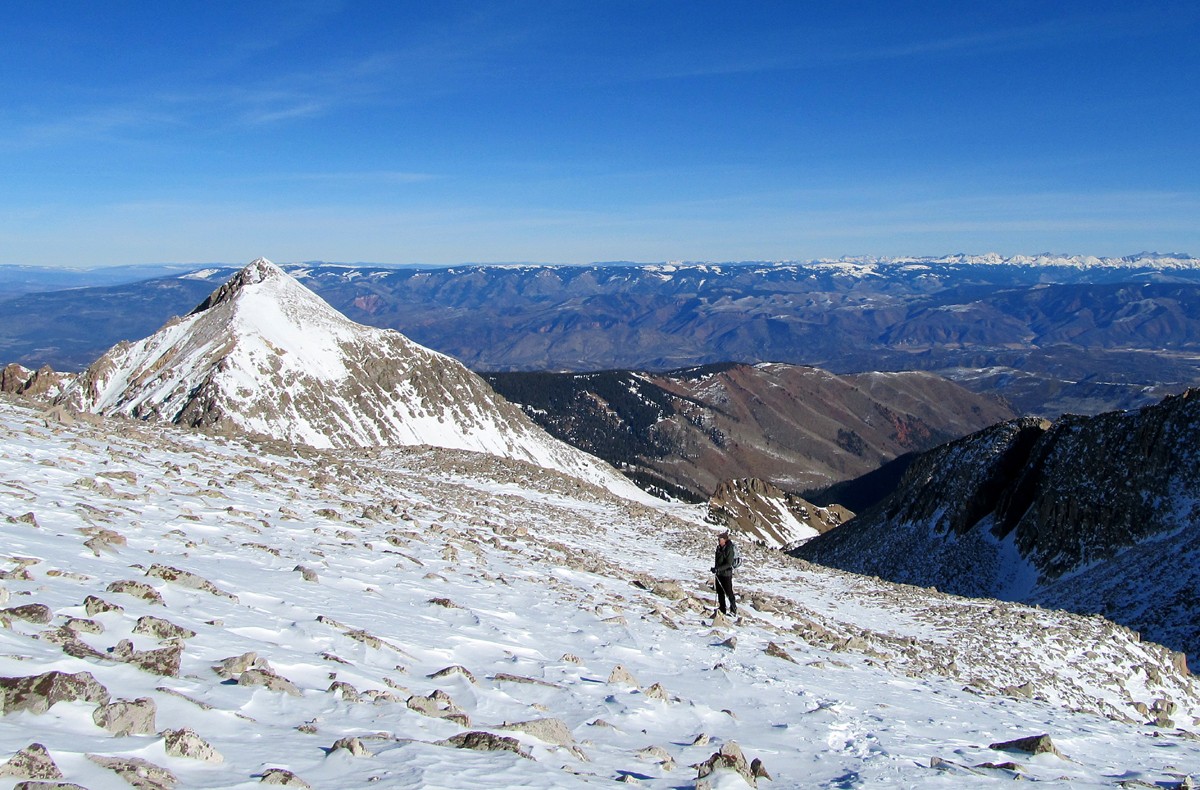
Daly in the background.


K2 in winter.
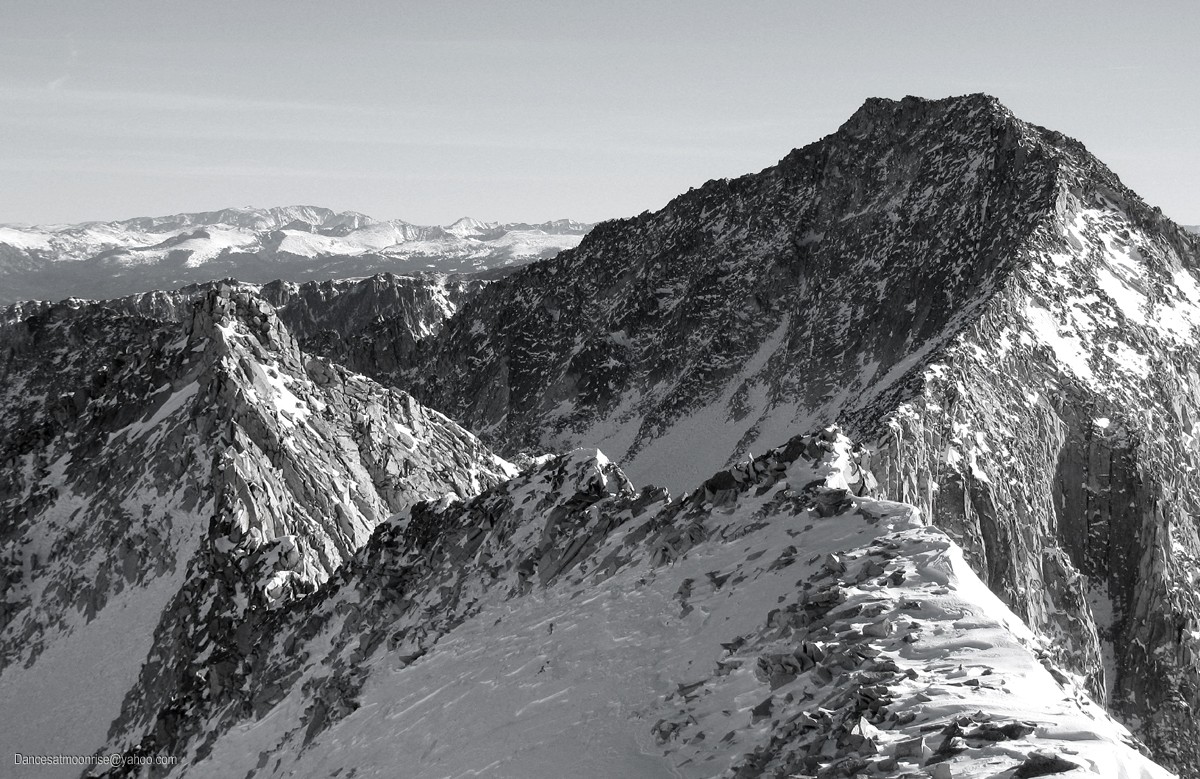
Clark Peak.
We get to the PLB overlook, take a break, and assess our route. To me, it's looking pretty good. As we don gear, I learn I've made a packing error.
We have the 8.5mm x 60m Mammut, instead of the lighter 8.1mm x 60m PMI. But now that we've got it here, this is even better, as it is a stronger
rope, and more resistant to failure over a sharp edge. I've also brought a full set of stoppers, an old set of rigid-stem Friends (from Jim's smithsonian
collection, circa 1983 - don't laugh, they're lighter than modern-day cams,) and a rack of dyneema runners and ultralight biners. We gear up with
harnesses and crampons, stash some unneeded items, and get started.
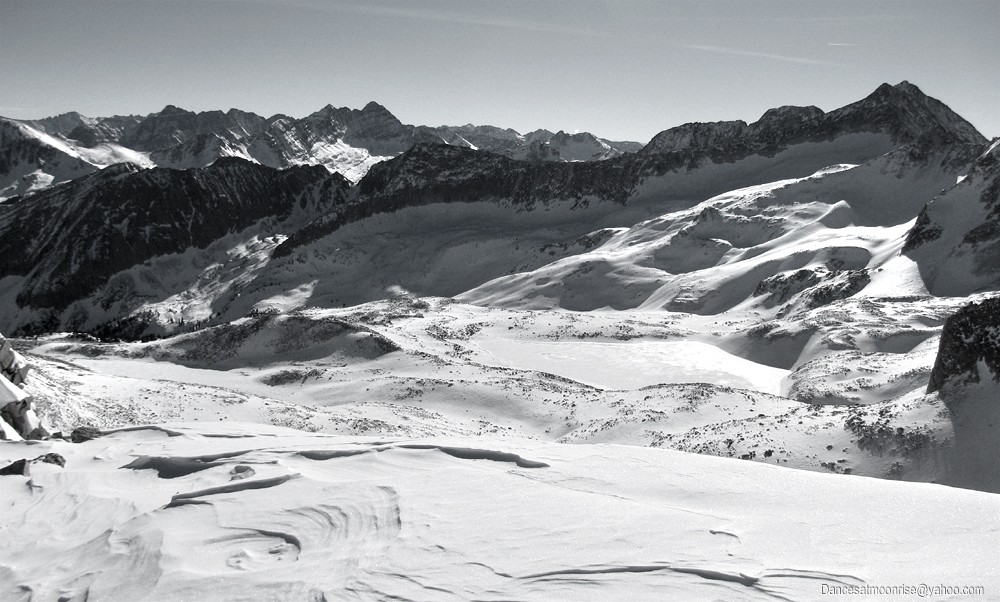
View from the overlook just below K2 on the Clark-K2 ridge.

The winter beauty is unreal.
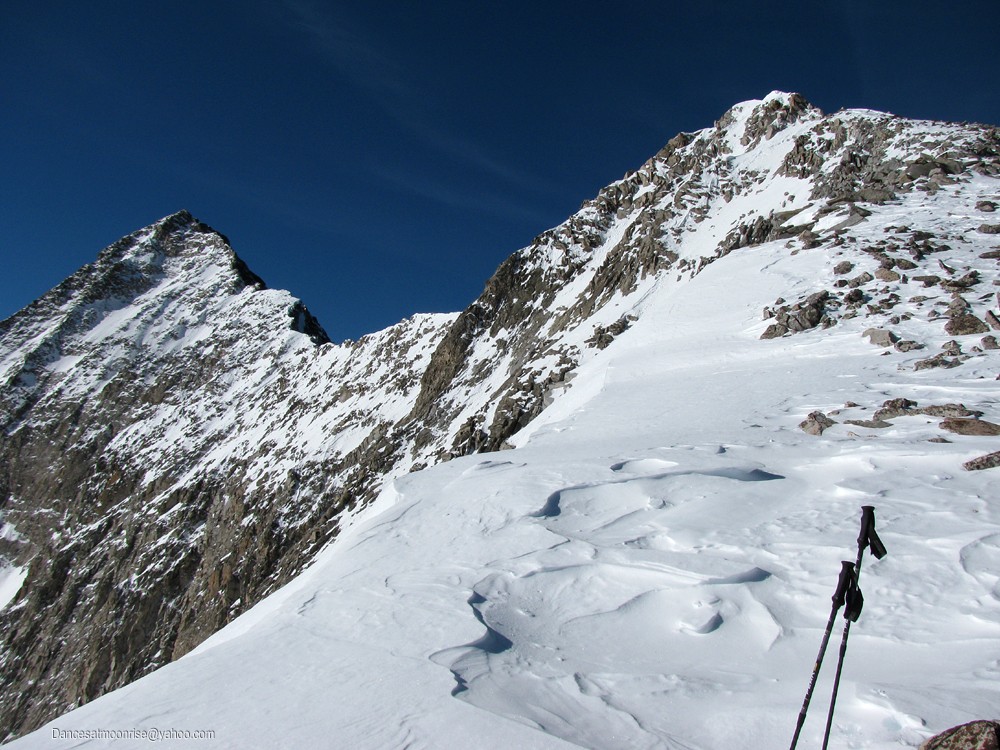
The Clark-K2 overlook affords views of the expansive PLB as well as the SW aspect of the Capitol Peak summit ridge.
Jamming up K2 in crampons, unroped, is a blast. It's great to be back rockin' in 'pons! As we come across the top and start the backside downclimb,
ecstasy sets in. I'm firmly in the zone. Joyful, intense focus.
Everything is going according to plan. We're less than 500 feet from the summit, it's Noon, we have great conditions, the day is warm, the temps are
in the low thirties, and there is no wind. We have a three-quarter waxing moon on the rise, which will be high in the sky by sundown. I can't wait
to get to the knife-edge and get roped up.
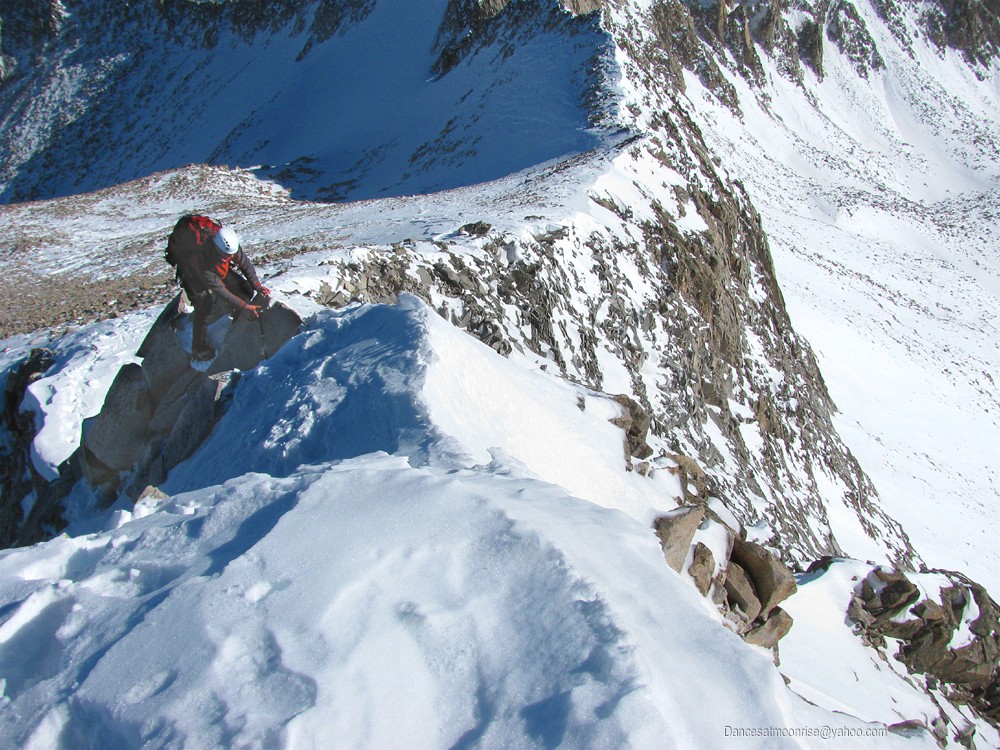
"You got it, Bobby! Stay with it, man!!"
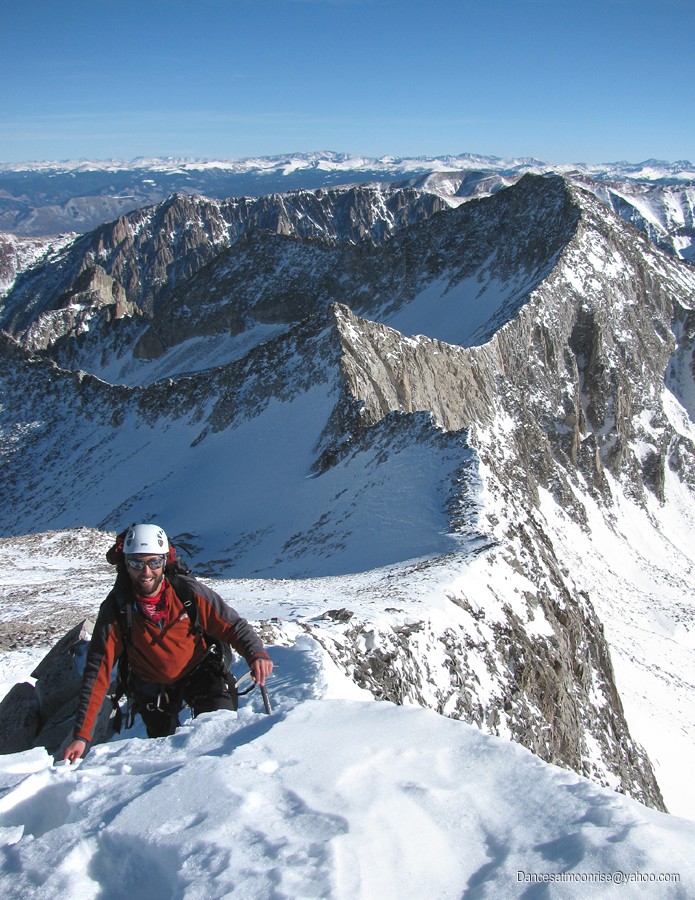
A happy dude.
But as we make our way from K2 across the ridge to the knife-edge, I notice Bobby begins looking a bit pallid. I ask him to get some photos.
I'm puzzled at his response. He says he's not taking any photos and just wants to hurry up and get the summit. This is a distinct change in my partner's
demeanor; he isn't exhibiting any signs of altitude dysfunction, but my antennae are definitely up.
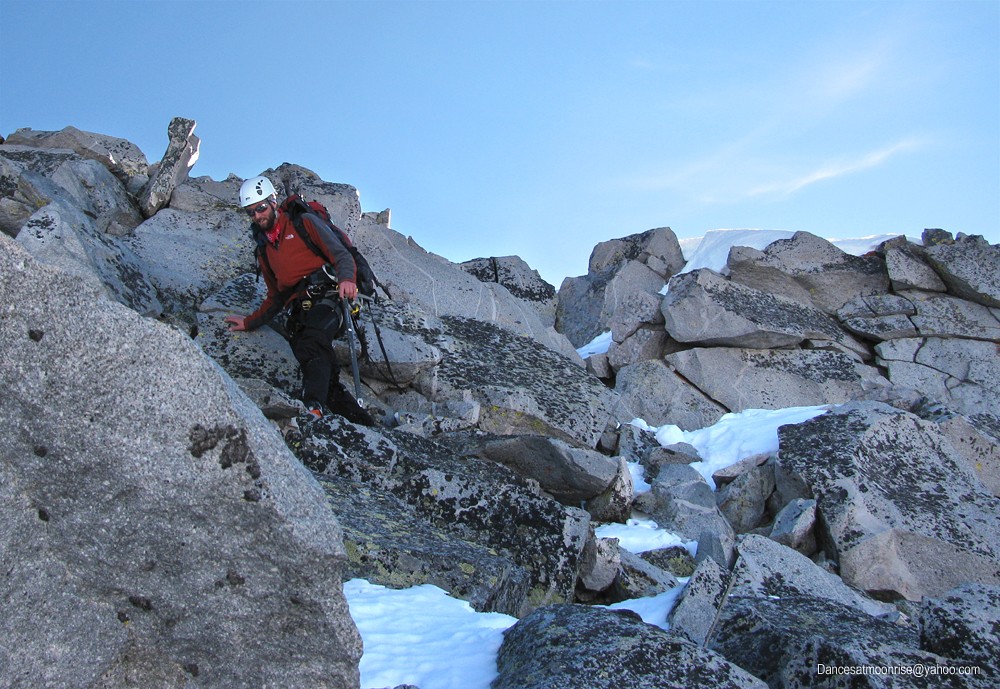
Downclimbing the "back side" of K2.
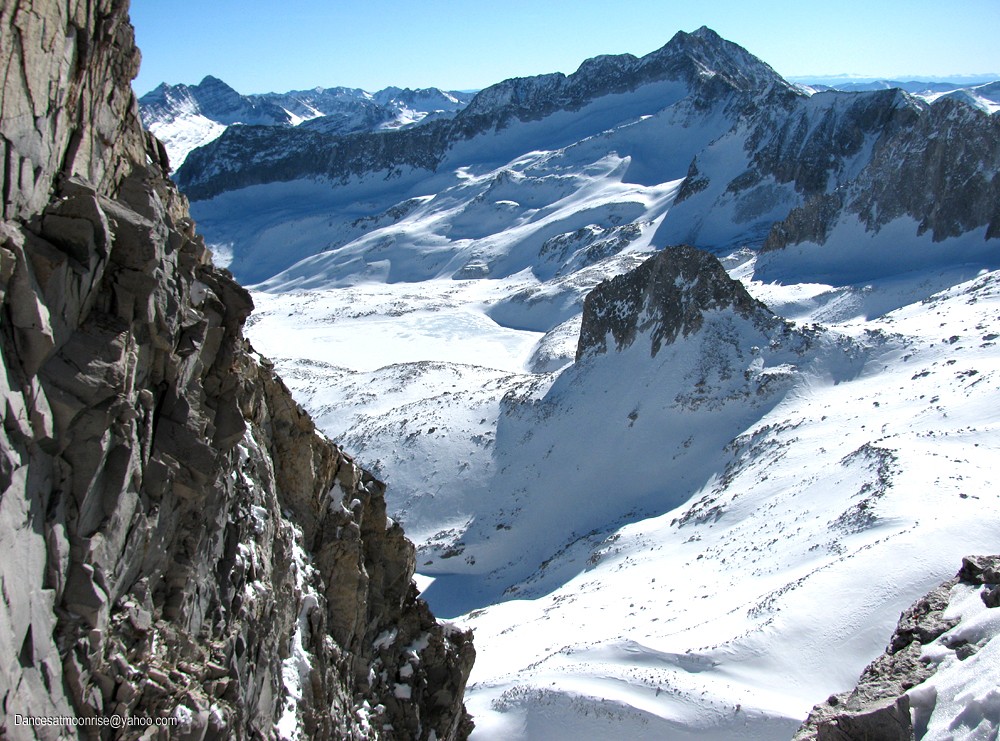
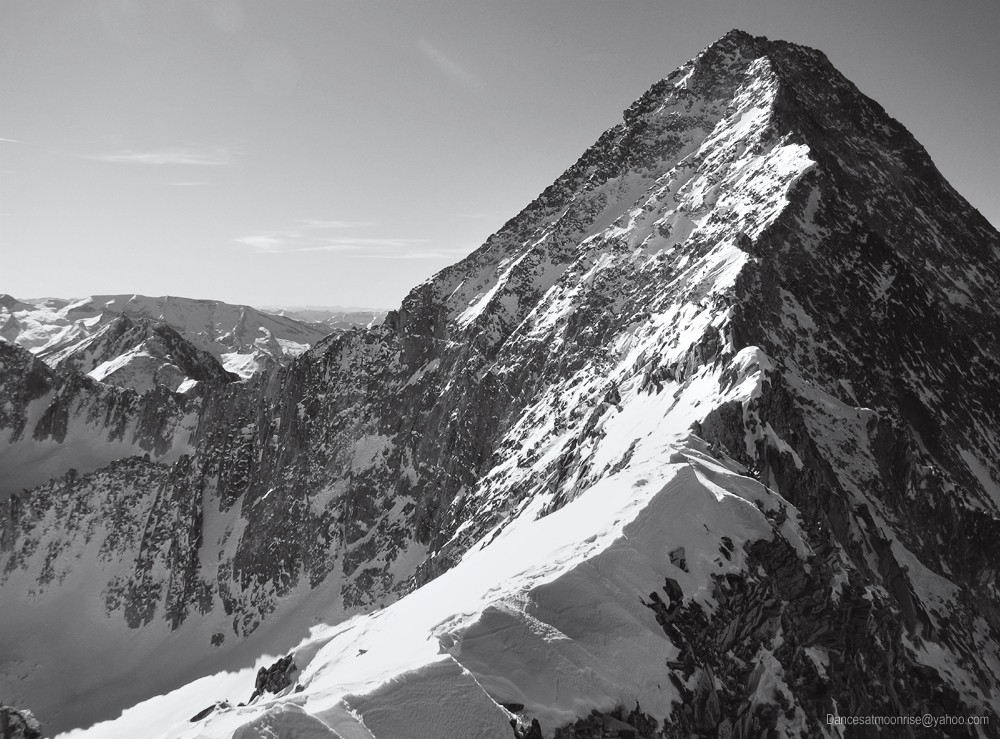
I turn to our first sketchy section. The right side is sheer. The left side is covered in poor sugar snow, but the top is a solid edge. I hold on to the top
with both hands, occasionally brushing snow off holds, while traversing across. I know feet are going to be unreliable on this section, but hands are solid.
I'm sticking front points into the snow, and predictably, the snow crumbles in places. It's not a big concern because hands are good, though after getting
across this short section and back onto firmer ground, I'm thinking it's getting time to rope up.
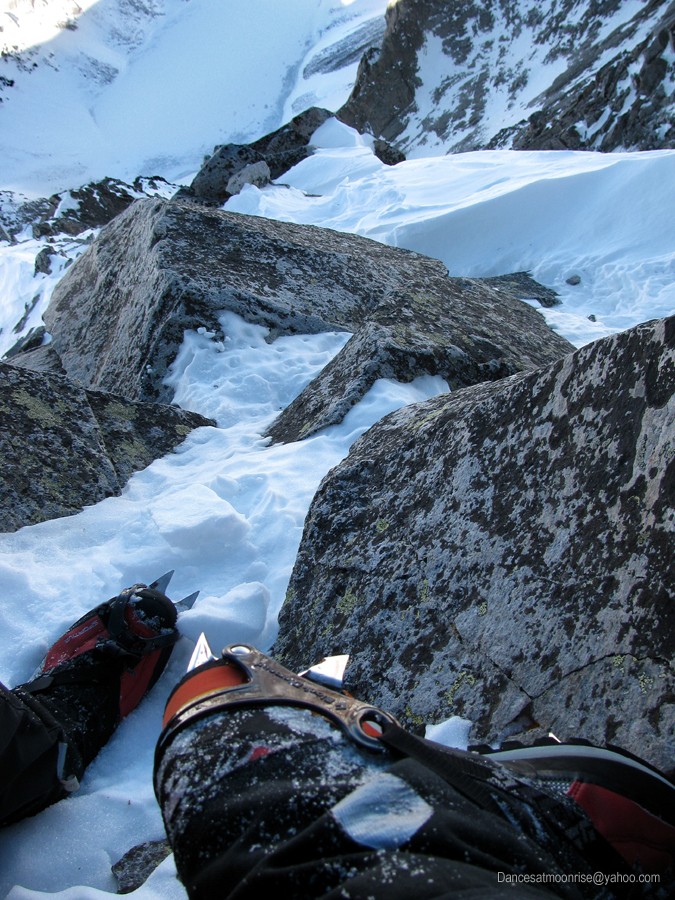
That's Capitol Lake down there, about one step left and 2000 feet below.
I look back and Bobby is having second thoughts. He tells me he's uncomfortable with the snow. I tell him to toss an end of the rope; I'll set an anchor,
and bring him across. He's uncomfortable with the idea, so I reverse the section, still unroped. I'm a little more impressed with the difficulty
this time, but to my surprise, I find the axe to be an incredible, multi-positional, passive device for making self-belay placements in alpine rock.
It's truly a revelation, how many different ways the various parts of an axe can wedge and cam into the rock. I practice self-belay rock placements
as I traverse back over to Bobby. We go back to a wider ledge, and I figure we'll rope up here. I do not realize yet, that we've already gone as far
as we're going to get on Capitol's summit ridge today.
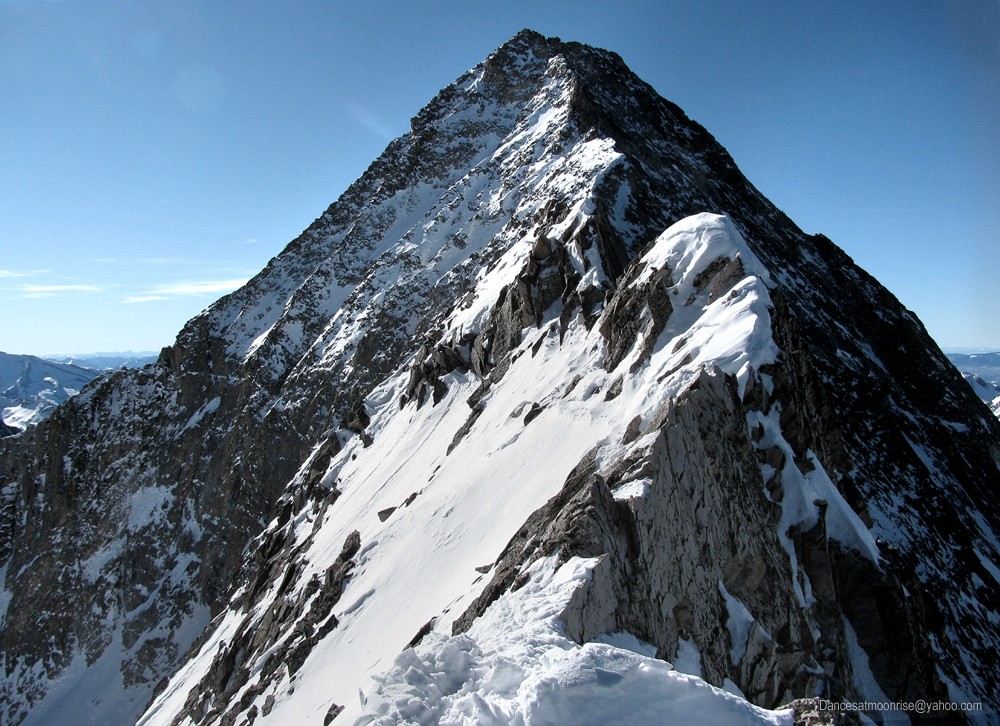
Looking back during the descent, shortly after the turn-around point.
Bobby is definitely not himself. I try to explain that we'll be fine if we're roped and anchored. Logic is not the answer. Although it's a hard pill to swallow,
I realize my partner is not doing well, and the best decision I can make is to turn us around. We get back up K2 just fine, so I'm pretty sure it's not altitude.
Since we're not going to summit, we have plenty enough daylight. I decide it's time to have a trad-placement session. What better time and place
than this gorgeous day out here on K2 in January.

K2 on the way back.
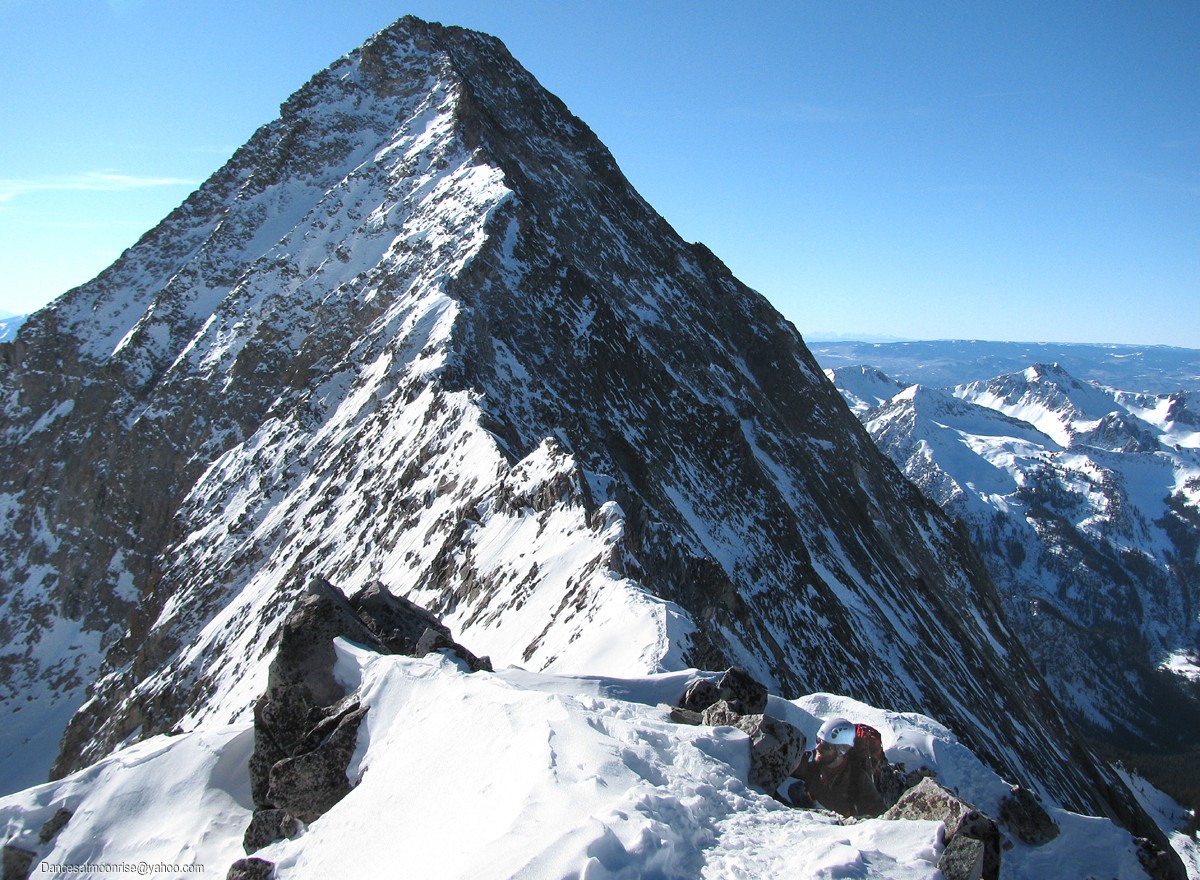
Bobby looking a little more chipper regaining K2
We break out the ropes and gear on K2. I have Bobby belay me down to the rock, where I put in several placements on the way down, and stop half-way
to belay him. We play with rope and placements for a while, then I belay him from my anchor half-way up K2, back down to the safe terrain below, undo
the anchor, and walk off on belay.
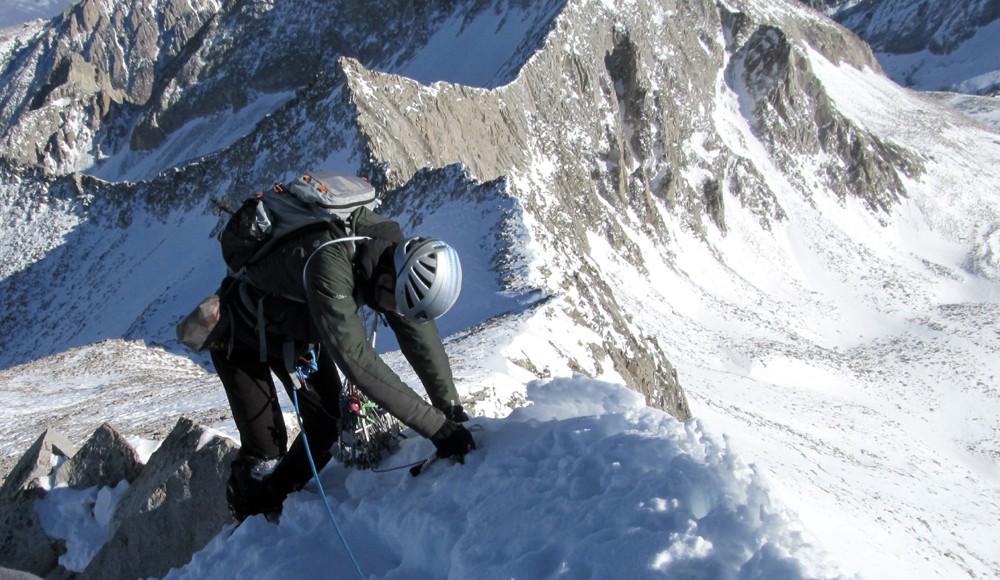
Downleading K2, we finally get to play with the toys.
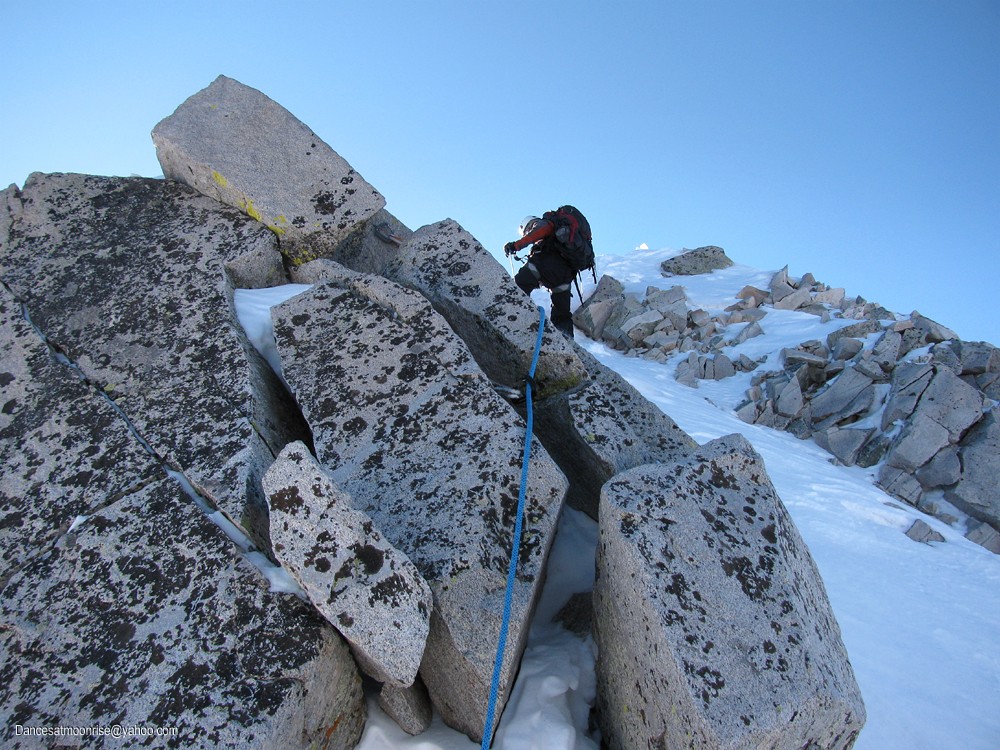
Bobby seconds K2 on the descent...
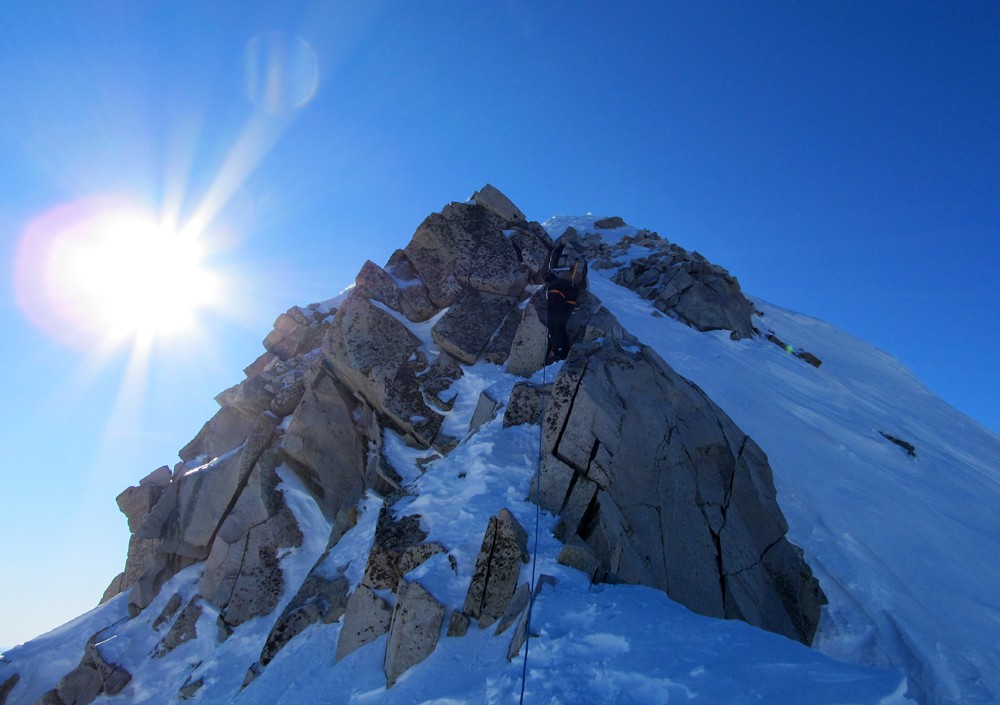
...and I pull the anchor and walk off on belay.
I've learned a few things today. The multiple revelations about the axe as a passive rock tool have come straight from the Almighty Himself. I'm wondering
if there's a section in the mountaineer's bible that I missed. I also realize that the reason the old-school style of gear on a shoulder sling works is because
most routes you're doing are vertical to overhanging, and the gear hangs out of your way, whereas on alpine routes, which are more often lower angle,
it hangs in your way. That fancy new Camp Alp 95 harness weighs only 4 oz, but doesn't have gear loops, so I'll need to figure out an efficient method
for racking gear for alpine routes.
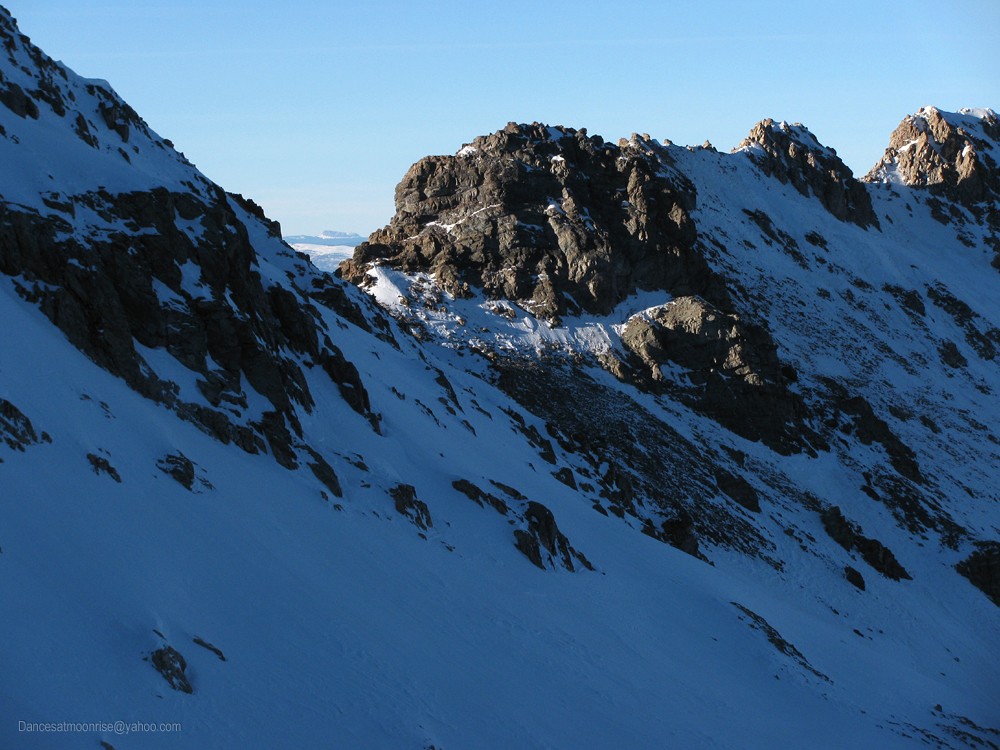
The Capitol Daly saddle.
As we gear down and prep for the descent, Bobby is himself again. In fact, I laugh because he's saying how much safer it seems on the rope, and he
thinks we could get the summit just fine if we protect it. I smile, and know that the reality is, we'd probably have been too slow, anyway. As soon as
you start playing with ropes, time goes into dreamland, and right out the window. While the ropes are in use, each guy on the team must constantly
be thinking about the clock, and busying himself with some part of the rope management. In retrospect, while allowing three hours from K2 to the
summit, and two hours back, with the goal of being off K2 by dark, would be reasonable with two very experienced climbers, I'd think that being on K2
as early as possible; even 8:00 am, would not be a mistake.
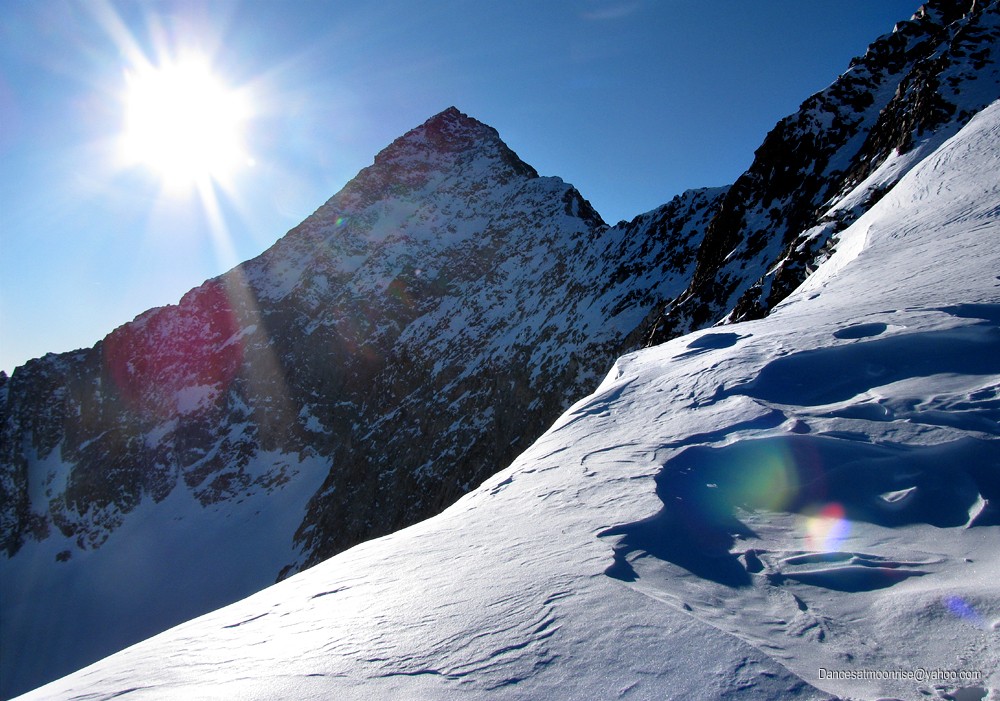
As we plod back down the long approach, I become moody. I start feeling like we wasted a great opportunity. We had relatively low avy danger,
a perfect weather day, good conditions on the technical section, every piece of gear we needed, and we made K2 within an hour of our anticipated
time of 11am. The work of getting here was the ante up, and we did all that, only to turn back. I become despondent and quiet as I plod along.
Suddenly, Bobby is far enough behind me that I can no longer see him. I continue pouting for about another ten minutes, entering the trees, till I realize
that Bobby is not slow, and if he's that far behind me, something is wrong. I shake off my crappy attitude, set down the pack, take a break, and
come up with a plan if he doesn't show up pretty quick. I have about five minutes to myself to imagine the multitude of ways my indulgence in self-pity
can endanger both our lives: a rather sobering revelation. I start to sort what I can stash to head back up, when I hear Bobby's snowshoes coming
through the trees. We look at each other for a minute and start laughing. I realize he's just as bummed we didn't get the summit, if not more so.
We make our way through the thick drainage and then back up the side of the hill, where it's a warm, moony evening. We're both exhausted, but do
pretty well getting back to the cars. A long day in winter is good for the soul. Half-way home, I pull into the TH parking lot of a favorite 14er.
As expected, it's deserted. I lay down in the back of the car and immediately fall asleep. Two hours later I'm up and refreshed, ready to finish the drive home.
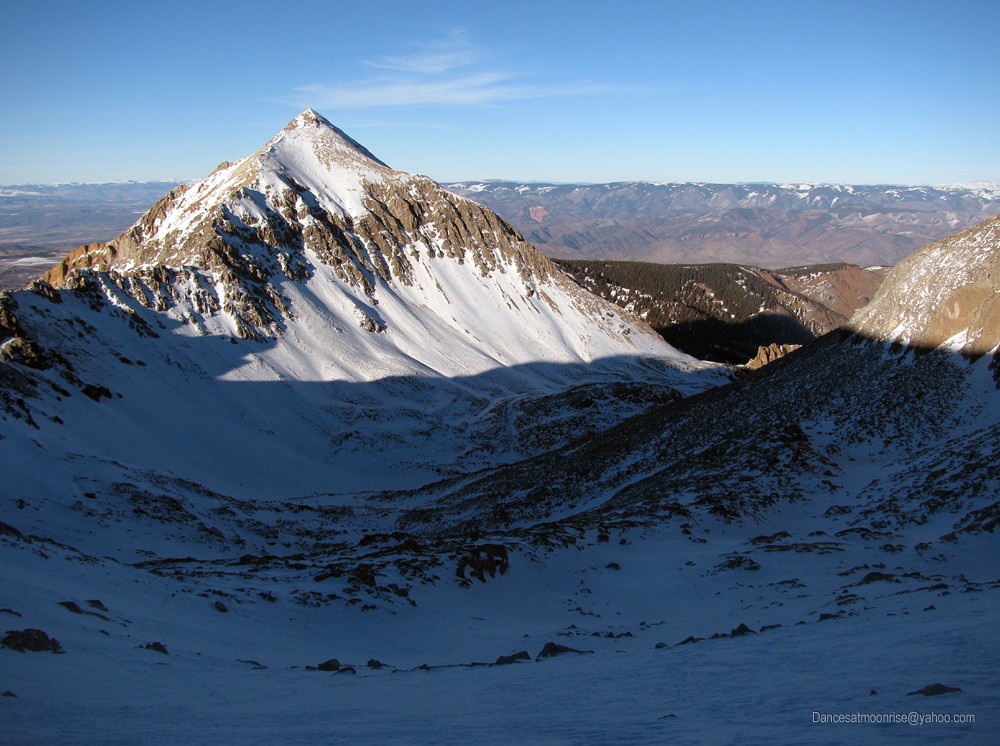
Mount Daly bathed in late afternoon light.
It only takes about 24 hours to realize how blessed we are. We stood atop K2 in January! What a dream, to do that. What an excellent recon.
I now know the route. Given the windslab and post-holing, we still made K2 in eight hours. An overnighter might be easier, but a daytrip is feasible,
given an early enough start. Still, how can I expect a successful summit the first time around, on one of the most difficult 14ers in winter,
when I only saw it for the first time three months ago? Little Bear, last January, did not yield till the third attempt, and remains one of my favorite trips ever.
Colorado winter 14eering is like peeling an onion. It's layer, after layer. It will take the time that it takes.
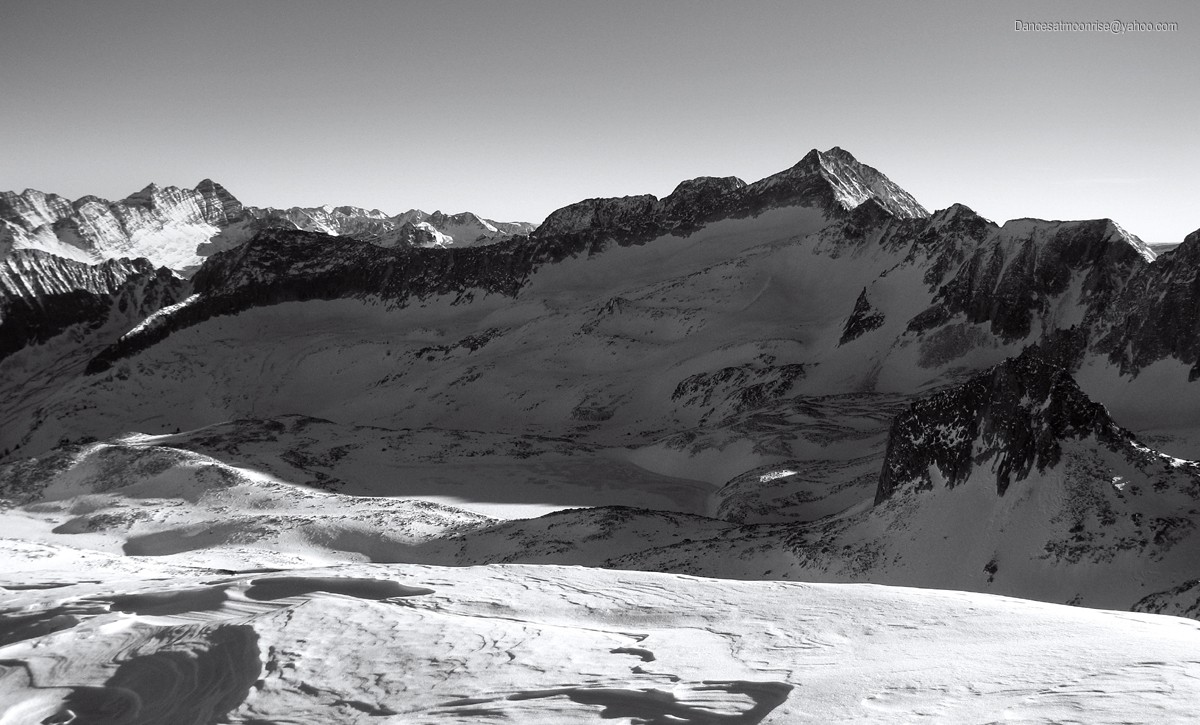
Hoping those of you interested in this route find the report helpful, and hope everyone enjoys the photos and text as much as we enjoyed this incredible
mountain on a fine winter's day.
Wishing all a safe, successful, and blessed winter season.
-Jim
.
|